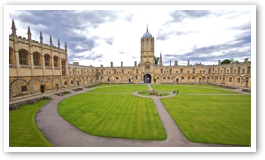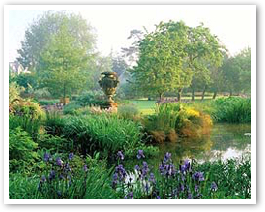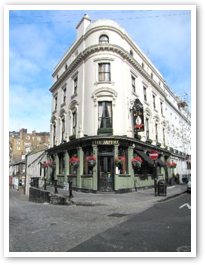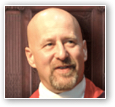An Imaginative Literary Tour of Oxford
- FATHER DWIGHT LONGENECKER
The independent fundamentalist church I went to as a boy gave me a fantastic amount of Bible knowledge.
 So come with me on a little literary tour of the city. We are going to start in the street called St Aldate's at the front gate of Christ Church. The tower over the gate is called Tom Tower for its bell called "Great Tom." Let's go through the gate into Tom Quad. It is the biggest "quad" or quadrangle in Oxford. We will skip the churchy history and point out that this was Sebastian Flyte's college in Brideshead Revisited. The fountain in the middle of the quad is nicknamed Mercury because it features a bronze statue of the god. You may remember that the aesthete Anthony Blanche was thrown into Mercury by some hearties. Modern spoilsports have got the custom banned.
So come with me on a little literary tour of the city. We are going to start in the street called St Aldate's at the front gate of Christ Church. The tower over the gate is called Tom Tower for its bell called "Great Tom." Let's go through the gate into Tom Quad. It is the biggest "quad" or quadrangle in Oxford. We will skip the churchy history and point out that this was Sebastian Flyte's college in Brideshead Revisited. The fountain in the middle of the quad is nicknamed Mercury because it features a bronze statue of the god. You may remember that the aesthete Anthony Blanche was thrown into Mercury by some hearties. Modern spoilsports have got the custom banned.
At the right corner of the quad is a doorway that leads to a grand staircase up to the college hall. You might recognize the staircase and hall. It stood in for Hogwart's in the Harry Potter films. Just inside the hall to the right is a portrait of Lewis Carroll (real name Charles Dodgson). The author of Alice's Adventures in Wonderland was a mathematics don at Christ Church. Alice Liddell was one of the daughters of the dean. Did you know Dodgson was an Anglican deacon and an inventor? He invented a steering mechanism for tricycles and a special gadget for taking notes in the dark, so when you woke up with an idea you would not lose it. John Crowe Ransom studied here. So did W. H. Auden.
Come on, we will cut across the quad and out the neo-classical back gate of Christ Church into the most charming and medieval part of Oxford — Merton Street. The walls of golden stone surround you and the narrow street invites you to wander without the noise and hazards of motorcars. Oriel College is on the left. That was Blessed John Henry Newman's college. They have turned his little oratory into a mini shrine to the great man, and installed a stained glass window in his honor. Newman left Oxford just five years before Dodgson (Lewis Caroll) arrived. Hodgson and his clergyman father were Anglo Catholics and much influenced by Newman. Around the corner, to the right and along the narrow lane is Merton College. T. S. Eliot studied there in 1914. There is a new lecture room named after him. The obscure, third-rate Anglo-American writer Dwight Longenecker played Horatio in a student production of Hamlet in Merton Chapel in 1980. It was a forgettable performance.
 If we wander down cobbled Merton Street we will avoid the traffic on the High Street and find ourselves almost at the entrance to C. S. Lewis’ Magdalen College. First we will stop at the botanic gardens — a hidden secret in Oxford. Not only did the fictional Sebastian Flyte stroll through the gardens, but Lewis Caroll loved spending time there, and until recently an ancient Black Pine grew here which was the inspiration for J. R. R. Tolkien’s ent, Treebeard.
If we wander down cobbled Merton Street we will avoid the traffic on the High Street and find ourselves almost at the entrance to C. S. Lewis’ Magdalen College. First we will stop at the botanic gardens — a hidden secret in Oxford. Not only did the fictional Sebastian Flyte stroll through the gardens, but Lewis Caroll loved spending time there, and until recently an ancient Black Pine grew here which was the inspiration for J. R. R. Tolkien’s ent, Treebeard.
Watch your step as you cross the busy high street to enter Lewis land. You can visit the chapel at Madgalen where he worshipped daily and as you pass through the quad to the left through an archway you will see the "New Buildings" where C. S. Lewis kept the rooms where he would tutor his students and where the Inklings would head after the pubs closed to continue their rowdy meetings. Did you know the poet John Betjeman was a student of both C. S. Lewis and T. S. Eliot? Lewis at Magdalen and Eliot when Betjeman was a boy at Highgate School where Eliot taught for one unhappy year.
Turning to the right you will see a gate opening into what looks like woodland. It is the semi-wild park that runs beside the River Cherwell. There is Addison's Walk, named after the eighteenth century essayist. Lewis, Tolkien and Hugo Dyson walked this circular walk that frosty night when they had the important conversation about myth that helped bring Lewis to the point of his conversion to Christianity.
We will have to cope with the traffic and noise of the High Street now. As we walk up past the shops you will spot a grand neo-Gothic structure called "Examination Schools." This is where Lewis and Tolkien lectured and Charles Ryder fell asleep. A bit further along "the High" is University College where Lewis did his undergraduate studies. The poet Shelley was expelled from University College for atheism. There is a memorial to him in the college — a marble carving of him drowned. Alas, the fate of the romantic: to die young or to cease to be a romantic!
Nipping back across the high street, we will watch out for red double decker buses, black cabs and students on battered bicycles with gowns a flapping. Jostling with crowds of tourists, we have to visit the church of St. Mary the Virgin — the University Church. This is where Blessed John Henry Newman was vicar from 1828-1843. In that pulpit not only stood John Henry Newman, but C. S. Lewis preached his famous sermon, The Weight of Glory, here. John Wesley preached here and Thomas Cranmer — author of The Book of Common Prayer along with the Hugh Latimer and Nicholas Ridley — were tried in this church for heresy before being burnt at the stake in the Broad Street just a few hundred yards away.
 If we go up the High Street a bit further and turn right we will come into the delightful little street called "The Turl," which links the High Street to the Broad. On the corner is the historic inn The Mitre. T. S. Eliot met C. S. Lewis there for lunch one day. It was an uneasy meeting. They were reluctant allies. As we go up the Turl we will peep into Lincoln College on the right. That is where John Wesley was a fellow and where Methodism got started. Dr. Seuss (Theodore Geisel) did graduate work here, and the poet Edward Thomas was a Lincoln alum. A bit further down the Turl is Exeter — Tolkien's college. We will stop in to see the bust commemorating him in the chapel.
If we go up the High Street a bit further and turn right we will come into the delightful little street called "The Turl," which links the High Street to the Broad. On the corner is the historic inn The Mitre. T. S. Eliot met C. S. Lewis there for lunch one day. It was an uneasy meeting. They were reluctant allies. As we go up the Turl we will peep into Lincoln College on the right. That is where John Wesley was a fellow and where Methodism got started. Dr. Seuss (Theodore Geisel) did graduate work here, and the poet Edward Thomas was a Lincoln alum. A bit further down the Turl is Exeter — Tolkien's college. We will stop in to see the bust commemorating him in the chapel.
The Turl opens out into the Broad where more of literary Oxford awaits. Around the corner beyond the Bodleian Library is Hertford College where Charles Ryder and his creator Evelyn Waugh were students. Tucked in behind that is the Turf Tavern where Oxford sleuth Inspector Morse downs a pint, and a bit further on, if you know how to find St. Cross churchyard, we could look for the grave of Charles Williams.
But my feet are tired. Let us cross the street. We will resist the temptation to duck into Blackwell's bookshop — the world's greatest Aladdin's cave for bibliophiles. Instead we'll turn left, pass the cross in the middle of the street that marks the site of Cranmer's martyrdom, then turn right behind the Anglo Catholic church of St. Mary Magdalen. Across the street is the Randolph Hotel where C. S. Lewis first met his future wife Joy Davidman. The broad avenue in front of us is called St. Giles. St. John's College is behind those mellow golden stone walls on the right, Further up St. Giles on the left is the Oxford Oratory where poet Gerard Manley Hopkins served as a Jesuit priest and where J. R. R.Tolkien attended Mass nearly every day.
We will get there later, but for now we have got to stop at a famous watering hole. The Eagle and Child pub is here, and I do not know about you, but I could use a pint of cool brown ale and imagine that Lewis, Tolkien and the other Inklings had just settled down to solve the world's problems.
 This is Meaghen Gonzalez, Editor of CERC. I hope you appreciated this piece. We curate these articles especially for believers like you.
This is Meaghen Gonzalez, Editor of CERC. I hope you appreciated this piece. We curate these articles especially for believers like you.
Please show your appreciation by making a $3 donation. CERC is entirely reader supported.

Acknowledgement
 Father Dwight Longenecker. "An Imaginative Literary Tour of Oxford." The Imaginative Conservative (February, 2015).
Father Dwight Longenecker. "An Imaginative Literary Tour of Oxford." The Imaginative Conservative (February, 2015).
Reprinted with permission from The Imaginative Conservative. See the original article here.
Standing on my head is the blog of Father Longenecker on Patheos.
The Author
 Father Dwight Longenecker serves as the pastor of Our Lady of the Rosary parish in Greenville, South Carolina. Father Longenecker studied for the Anglican ministry at Wycliffe Hall, Oxford and served for ten years in the Anglican ministry as a curate, a chaplain at Cambridge and a country parson. In 1995 he and his family were received into full communion with the Catholic Church. He is the author of more than twenty books including: Beheading Hydra, Praying the Rosary for Inner Healing, Listen My Son: St. Benedict for Fathers, More Christianity, Challenging Catholics: A Catholic Evangelical Dialogue, St. Benedict and St. Therese: The Little Rule & the Little Way, Mary: A Catholic-Evangelical Debate, and The Path to Rome. You can follow his writings, listen to his podcasts, join his online courses, browse his books, and be in touch at DwightLongenecker.com.
Father Dwight Longenecker serves as the pastor of Our Lady of the Rosary parish in Greenville, South Carolina. Father Longenecker studied for the Anglican ministry at Wycliffe Hall, Oxford and served for ten years in the Anglican ministry as a curate, a chaplain at Cambridge and a country parson. In 1995 he and his family were received into full communion with the Catholic Church. He is the author of more than twenty books including: Beheading Hydra, Praying the Rosary for Inner Healing, Listen My Son: St. Benedict for Fathers, More Christianity, Challenging Catholics: A Catholic Evangelical Dialogue, St. Benedict and St. Therese: The Little Rule & the Little Way, Mary: A Catholic-Evangelical Debate, and The Path to Rome. You can follow his writings, listen to his podcasts, join his online courses, browse his books, and be in touch at DwightLongenecker.com.




